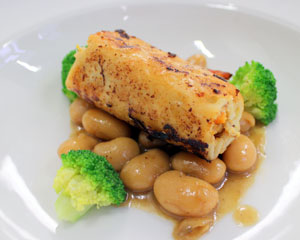
It seemed ages since the façade of five-star, almost century-old, Meikles Hotel wasn’t clad with builders’ scaffolding and wreathed in tarpaulin sheets, as a US$8 million facelift continued apace.
Eating Out with Dusty Miller
But tarps are now off; scaffolding dismantled; final bits of plaster, cement and brick-dust vacuumed, after the last builder left the site.
And the much-loved by generations of Zimbabweans grand-old lady of Africa Unity Square, blooming after a major re-furb, is back in business with a vengeance.
I’m a bit cynical about refurbishments of major hotels, being ultra-conservative with a lower-case “c”. I thought there really wasn’t much wrong with the “old” hotel (apart from the temperamental, totally inefficient, air-conditioning system and a car-park lift kaput since Pontius was a Pilot!)
Old fogeys like me may very well mourn the passing of acres of sober dark hardwood panelling throughout the hotel, to be replaced with much lighter timberwork or hectares of gleaming mirrors, rather than celebrate the re-birth of this beaming, detoxed and botoxed dowager.
Meikles this week held two lunchtime chef’s tables in the made over La Fontaine kitchen. Invited guests were mainly foodie journalists, diplomats and other opinion formers and decision makers. I was fortunate enough to be invited on the first one (Monday), which proved a delightful occasion, if a bit of a gastronomic assault course as seven courses with appropriate wines, plus coffee were sampled.
The event was a little more surreal than it would have been, anyway, due to the presence of several swarthy sub-continental looking be-toqued chefs, working with a Meikles cooking staff which was mainly well-known to me.
- Chamisa under fire over US$120K donation
- Mavhunga puts DeMbare into Chibuku quarterfinals
- Pension funds bet on Cabora Bassa oilfields
- Councils defy govt fire tender directive
Keep Reading
“Who are these guys who look as if they should be wearing turbans?” I asked the Meikles GM on my right-hand side.
“They’re cooking for our Indian special week which starts today. Didn’t you know about it?”
Well no, I didn’t! And if I didn’t, then most of our thousands of readers wouldn’t either.
True, I’d been away at Kariba for the Tiger tournament for a week, but there was nothing in my in-box about the event, which I thoroughly enjoyed last year. Tut! Tut!
Academic worth There and then I received a verbal invitation to an Indian supper, but as the thematic special was only for a week and you’ll read about it (if I actually make it) way after these chefs are back on their ranges in Delhi, Dalhousie or Dumdum, it can be only of academic and archival worth.
I suspect several of us were newcomers to the chef’s table concept, as there was much oohing and aahing when lovely, colourful floral decorations, snowy crisp table linen, solid silver cutlery and sparkling crystal ware discovered in the busy working kitchen.
In fact, it was the identical sort of old-fashioned, professional, service you would receive in La Fontaine, the hotel’s five-star grill room had you returned for supper or lunch the next day. That is to say pretty faultless!
First was a dinky, delicate demi-tasse of a fruit-filled home-made tomato soup served with tomato bread which was just jam-packed with dense, complex herby flavours, prominently basil. It was a soup to leave home for. Give me it in a workman’s pint chipped coffee mug and about a third of a loaf of the tomato bread (and butter) and you could safely forget about the next six courses!
We then proceeded to a second starter course, which was a light-as-air blue cheese mousse with celeriac (“ceramic” our waiter said!) crisps and macadamia nut dressing. Celeriac (turnip-rooted celery or knob celery) is a new one for me in this country, although I eat it often at my daughter’s home in the UK.
You can enjoy it raw or cooked and, if the latter, it can be boiled, roasted round the joint or stewed or mashed; or add slices or dices of it in a really good soup.
I don’t know who’s growing it, but a big tick to that anonymous farmer or horticulturalist and a bigger tick for Meikles development chef, Zimbabwean-born Rory Lumsden, for using it so innovatively in this delicious dish.
Next up was a course I confidently expected some of the lovely ladies who lunched languidly around our table to refuse (and quite possibly some of the guys who graze with gusto!) It was rabbit!
A roulade-type presentation featuring lots of beautiful bunny rabbit flesh served on white beans (butter-beans, I think, rather than the Italian cannellini beans I associate with this sort of dish) with tapenade (purèed or finely chopped black olives, capers, anchovies and olive oil: a Provençal speciality often eaten as an hors d’oevres, spread on crusty bread; sometimes used for stuffing poultry) and very nice broccoli florets.
continued from S4
No one said “no, thank you” to Peter Rabbit (almost certainly farmed in this country, overseas I prefer wild ones with a much more gamey flavour. I earned my first few pounds shooting these for the pot and grey squirrels for a bounty on their tales…they also cook well!) I scribbled the phrase “The Tops!” after the next dish which was a deceptively simple, yet well-balanced roasted fillet of salmon with great garden peas and carrots, juicily, cooked to be eaten, not left on the side of the plate as they so often are. Most salmon seen in fishmongers and on sale at supermarkets here are either Norwegian or from Loch Duart in the Scottish Highlands, but we occasionally get Canadian varieties. I’ll not pretend I could discern the provenance of this particular fish, but it tasted superbly well. Most folk around me thought it was the best dish sampled that day and I’ll not gainsay them.
Wine flowed Which takes nothing away from what I suppose was purportedly the “main” course at this wonderful lunch party where conversation and humour sparkled and wine flowed like water used to do through bath and kitchen taps in this country.
That was very slowly braised shoulder of lamb with aubergine (eggplant/brinjal) purèe and splendidly tasty young vegetables. Globally, shoulder is a relatively cheap cut of lamb; but in Zimbabwe everything off Larry the Lamb is pretty dear, even the humble scrag end, from which my grand-mother used to make exquisite soup.
I’ve often suspected Lumsden deconstructs this economy joint in which he seems to specialise, then reconstructs it for serving, as fibres are often separate and loose. Nancy Benham from the British Embassy said she felt it a bit too sweet for her own particular palate, but I added extra mint sauce to enhance that sweetness. I enjoyed the purèe and relished garden peas and new potatoes among the “young veg”.
Meikles serves meals the English way with pudding (in this case a decadently rich, powerful chocolate fondant with vanilla ice-cream) served before cheese course.
No train smash, but I prefer the cheeses (perfectly kept Brie, Camembert, a piquant South African blue…whatever happened to our own grand prize-winning Kadoma Blue? Gouda…) and a spiced pear chutney with plump purple grapes, to be served as the penultimate course, in order to enjoy a little chilled Golden Pilsener Lager or the last drop of a favourite white or red wine with the dairy products.
We finished with a good rich filter coffee and while I didn’t hear where it came from, I picked up someone insisting the hotel should buy St Lucia coffee from Chiredzi. Nothing wrong with that and, of course, it reduces the carbon footprint of which tourists (hmm!) approve.
Nicest coffee I’ve tasted lately was at Middy’s in Bulawayo, where they grind their own secret blend using beans from Chiredzi and Chipinge.











